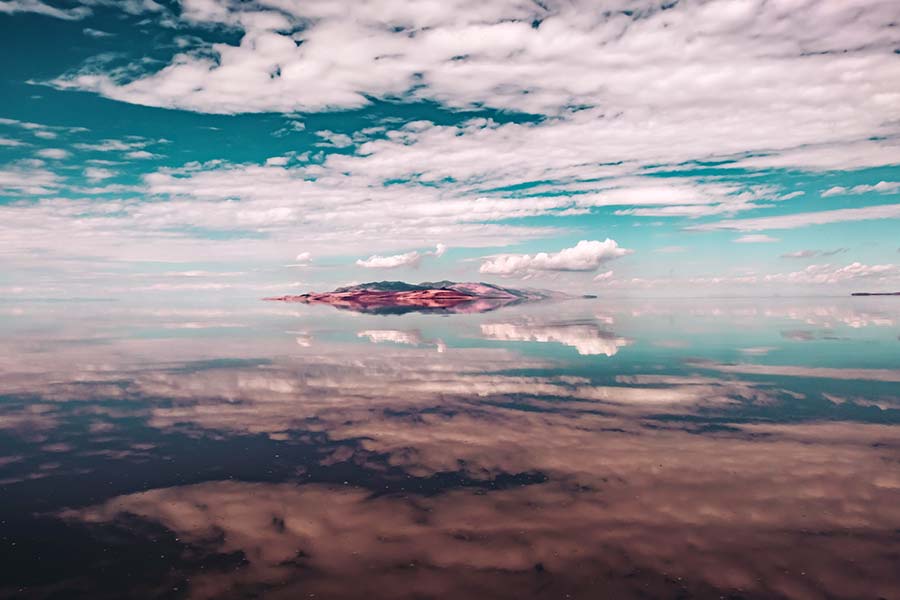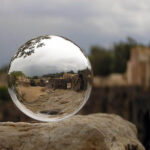Most of our discussion of refraction in this unit has pertained to the refraction of light at a distinct boundary. As light is transmitted across the boundary from one material to another, there is a change in speed, which causes a change in direction of the light wave. The boundaries that we have been focusing on have been distinct interfaces between two recognizably different materials. The boundary between the glass of a fish tank and the surrounding air or the boundary between the water in a pool and the surrounding air are examples of  distinct interfaces between two recognizably different materials.
distinct interfaces between two recognizably different materials.
It has been mentioned in our discussion that the refraction or bending of light occurs at the boundary between two materials; and once a light wave has crossed the boundary it travels in a straight line. The discussion has presumed that the medium is a uniformmedium. A uniform medium is a medium whose optical density is everywhere the same within the medium. A uniform medium is the same everywhere from its top boundary to its bottom boundary and from its left boundary to its right boundary. But not every medium is a uniform medium, and the fact that air can sometimes form a non-uniform medium leads to an interesting refraction phenomenon – the formation of mirages.
Refraction in a Non-Uniform Medium
A mirage is an optical phenomenon that creates the illusion of water and results from the refraction of light through a non-uniform medium. Mirages are most commonly observed on sunny days when driving down a roadway. As you drive down the roadway, there appears to be a puddle of water on the road several yards (maybe one-hundred yards) in front of the car. Of course, when you arrive at the perceived location of the puddle, you recognize that the puddle is not there. Instead, the puddle of water appears to be another one-hundred yards in front of you. You could carefully match the perceived location of the water to a roadside object; but when you arrive at that object, the puddle of water is still not on the roadway. The appearance of the water is simply an illusion.
Mirages occur on sunny days. The role of the sun is to heat the roadway to high temperatures. This heated roadway in turn heats the surrounding air, keeping the air just above the roadway at higher temperatures than that day’s average air temperature. Hot air tends to be less optically dense than cooler air. As such, a non-uniform medium has been created by the heating of the roadway and the air just above it. While light will travel in a straight line through a uniform medium, it will refract when traveling through a non-uniform medium. If a driver looks down at the roadway at a very low angle (that is, at a position nearly one hundred yards away), light from objects above the roadway will follow a curved path to the driver’s eye as shown in the diagram below.

Light that is traveling downward into this less optically dense air begins to speed up. Though there isn’t a distinct boundary between two media, there is a change in speed of a light wave. As expected, a change in speed is accompanied by a change in direction. If there were a distinct boundary between two media, then there would be a bending of this light ray away from the normal. For this light ray to bend away from the normal (towards the boundary), the ray would begin to bend more parallel to the roadway and then bend upwards towards the cooler air. As such, a person in a car sighting downward at the roadway will see an object located above the roadway.
Making Sense of The Refraction Phenomenon
Of course, this is not a usual event. When was the last time that you looked downward at a surface and saw an object above the surface? While not a usual event, it does happen. For instance, suppose you place a mirror on the floor and look downward at the floor; you will see objects located above the floor due to the reflection of light by the mirror. Even a glass window placed on the floor will reflect light from objects above the floor. If you look downward at the glass window at a low enough angle, then you will see objects located above the floor. Or suppose that you are standing on the shore of a calm pond and look downward at the water; you might see objects above the pond due to the reflection of light by the water.
So when you experience this sunny day phenomenon, your mind must quickly make sense of how you can look downward at the roadway and see an object located above the road. In the process of making sense of this event, your mind draws upon past experiences. Searching the database of stored experiences, your mind is interested in an explanation of why the eye can sight downward at a surface and see an object that is located above the surface. In the process of searching, it comes up with three possible explanations based upon past experiences. Your mind subtly ponders these three options.
· There is a mirror on the road. Someone must have for some reason placed a mirror on the road. The mirror is reflecting light and that is why I see an image of the oncoming truck when I look downward at the road.
· There is a glass window on the road. My gosh, do you believe it! Someone has left a glass window on the road. The glass window is reflecting light and that is why I see an image of the oncoming truck when I look downward at the road.
· There is water on the road. It must have rained last night and there is a puddle of water left on the road. The water is reflecting light and that is why I see an image of the oncoming truck when I look downward at the road.
Of the three possible explanations of the image of the truck, only one makes a lot of sense to the mind – there is water on the road. After all, while both glass windows and mirrors can reflect light, nowhere in your mind’s database of past experiences is there an account of a mirror or glass window being seen on a roadway. Yet there are plenty of times that a water puddle has been observed to be present on a roadway. Smart person that you are, you then conclude that there is a puddle of water on the road that is causing you to see objects located above the road when you sight downward at the road. The illusion is complete.



